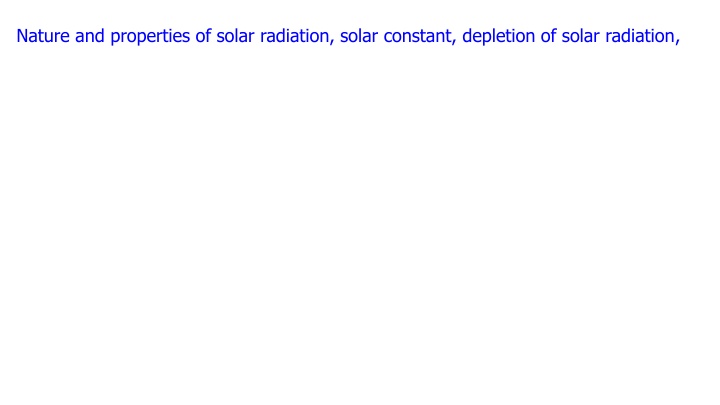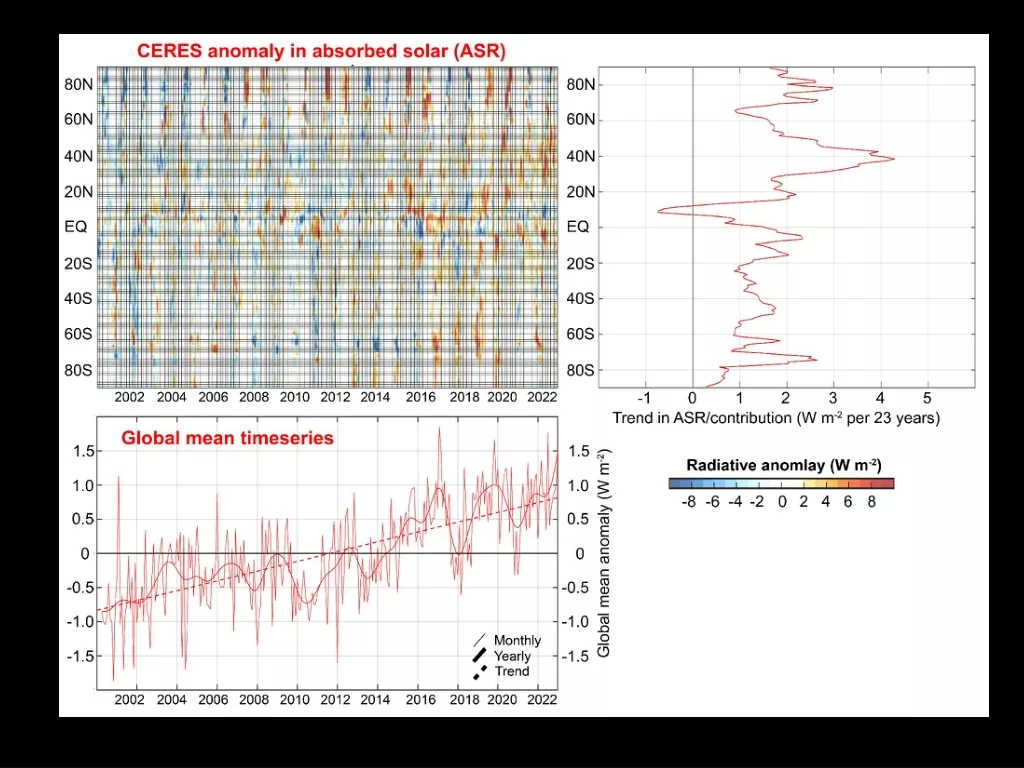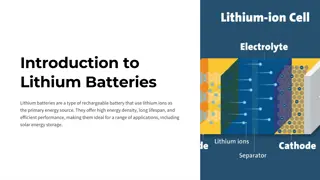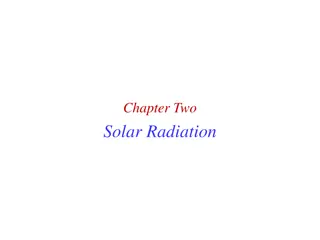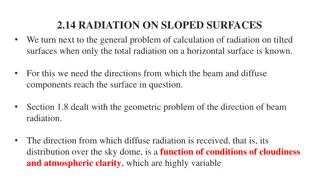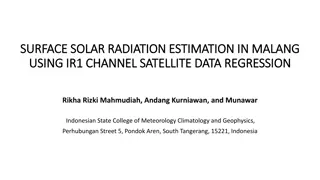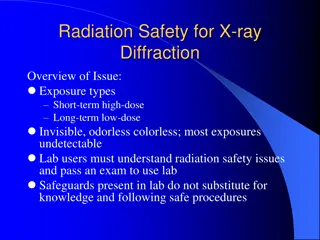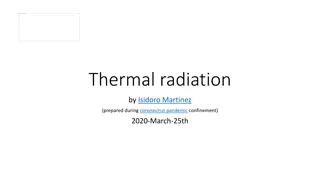Nature and Properties of Solar Radiation
Solar radiation, emitted by the sun, is pivotal for Earth's energy supply. This form of energy, transferred via electromagnetic waves, undergoes absorption, scattering, and reflection as it travels through the atmosphere. The different types of solar radiation, including diffused, direct, and global insolation, impact Earth's climate and energy balance. Understanding the wavelength and spectrum of solar radiation, as well as its depletion factors, is crucial for various applications, from renewable energy to environmental studies.
Download Presentation

Please find below an Image/Link to download the presentation.
The content on the website is provided AS IS for your information and personal use only. It may not be sold, licensed, or shared on other websites without obtaining consent from the author.If you encounter any issues during the download, it is possible that the publisher has removed the file from their server.
You are allowed to download the files provided on this website for personal or commercial use, subject to the condition that they are used lawfully. All files are the property of their respective owners.
The content on the website is provided AS IS for your information and personal use only. It may not be sold, licensed, or shared on other websites without obtaining consent from the author.
E N D
Presentation Transcript
Nature and properties of solar radiation, solar constant, depletion of solar radiation,
The sun is the only energy source to the earth. The earth revolves round the sun in an elliptical orbit. The earth is at its closest point to the sun (perihelion) on approximately January 3 and at its farthest point (aphelion) on approximately July 4. The sun is a completely gaseous body. The chemical composition of the outer layers is (by mass) 71% H, 26.5% He, and 2.5 % heavier metals. The core temperature is in the range of 1590 to 4240 0C. The core and interior fusion reactions (H transformed to He) take place. These reactions supply the energy radiated by the sun. The energy is first transferred to the surface of the sun and then radiated into space. The radiation from the core and interior of the sun is thought to be in the form of X rays and gamma rays.
Wavelength The wavelength of electromagnetic radiation is given by the equation = c/v Where, is the wavelength, the shortest distance between consecutive crests in the wave trans; c is the constant equal to the velocity of light, 3 1010 cm sec 1 ; and v is the frequency, the number of vibrations or cycles per second. Sun is continuously emitting short wave thermal radiation at various frequencies. The visible portion of thermal radiation ranges from approximately 0.4 m to 0.7 m. When solar radiation strikes the Earth s surface, it gets absorbed and is re-emitted as long wavelength thermal radiation. Thus, thermal radiations are a form of energy emission and depend solely on the temperature and the characteristics of the emitting surface.
As solar radiation passes through the atmosphere, some of it is absorbed, some is scattered, and the rest is reflected by: Air molecule; Water vapour; Dust; Cloud etc. The radiation reaching the Earth s surface through the reflectants / Absorbents is called diffused solar radiation. The solar radiation which reaches the Earth's surface without being diffused is called direct solar radiation. The sum of the diffused and direct insolation is called global insolation. Atmospheric conditions can reduce direct insolation by about 10% on clear, dry days and by 100% on thick, cloudy days.
The electromagnetic radiations have dual nature, behaving like waves and also like particles. As particles electromagnetic waves are called photons and energy E expressed as (Plank s Law): E = h * where E = energy of a photon in Joules, h = Planck constant = 6.6 *10-34 J s, and = frequency of radiation, s-1. When a beam of thermal radiation is incident on the surface of a body, the following could happen : (a) some of it may gets reflected away from the surface, (b) some of it may get absorbed by the body, and (c) some of it may get transmitted through the body.
The radiation characteristics of a surface are its ability to reflect (reflectivity), its ability to absorb (absorptivity) and its (transmissivity). These are defined as follows: = reflectivity = fraction of radiation reflected by the surface, = absorptivity = fraction of radiation absorbed by the surface, and = transmissivity = fraction of radiation transmitted through the surface. Thus, + + = 1 . . . (1.3) Most of the solid objects are opaque and hence = 0. If a body absorbs all the incoming radiation (such a body is called black body), we have = 0, = 1 and hence = 0. ability to transmit
Amount of radiation emitted per unit time from an unit area A (emissive power, Eb) of a black body at absolute temperature T is directly proportional to the fourth power of the temperature. Stefan-Boltzmann theory express Eb as: Eb = * T4 Where = Stefan-Boltzmann constant = 5.67 * 10-8 W m-2 K-4 and T is the temperature in degree Kelvin. According to Stefan Boltzmann law, Eb = P/A (P is net radiated power; A radiating area) An ideal black body is a perfect absorber as well as perfect emitter of thermal radiations. All real surfaces emit less energy than corresponding blackbodies.
Emissivity of a Surface The ratio of the total emissive power (E) of a real surface to the total emissive power (Eb) of a blackbody is called the emissivity ( ) of the real surface. Thus = E / Eb The emissivity of a surface is a function of following parameters : (1) surface temperature, (2) wavelength of the incident radiation, (3) direction of the incident radiation. When the emissivity is the average value over the entire wavelength range in all directions, is called total emissivity.
Kirchoffs Law The Krichhoff s law of radiation states that the monochromatic (single wavelength) emissivity is equal to the monochromatic absorptivity for any surface when in thermal equilibrium with its surroundings. This may be expressed as: (T ) = (T) where (T) temperature T is the monochromatic emissivity at wavelength and and (T) temperature T. is the monochromatic absorptivity at wavelength and
